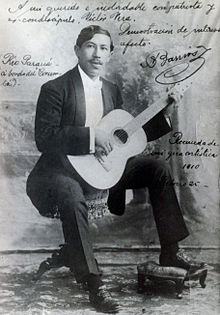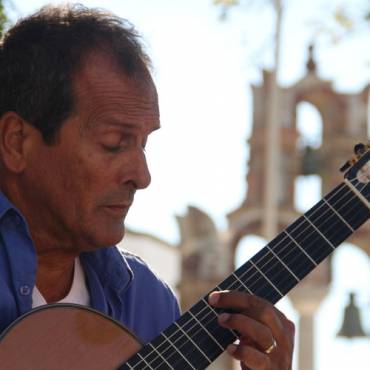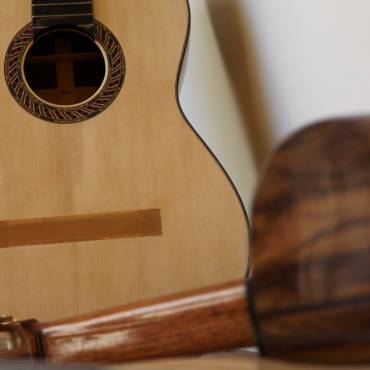Agustín Pío Barrios (also known as Agustín Barrios Mangoré and Nitsuga—Agustin spelled backward—Mangoré; May 5, 1885 – August 7, 1944) was a Paraguayan virtuosoclassical guitarist and composer, largely regarded as one of the greatest performers and most prolific composers for the guitar.[1]
It has been generally accepted that Barrios was born in San Juan Bautista, Paraguay. However, there is no definitive proof of this as his baptismal document found in the book of registries in the cathedral in San Juan Bautista does not state his precise place of birth. Also, several biographers and authorities present convincing documented evidence that Barrios was born, instead, in the nearby town of Villa Florida, Misiones, situated on the Tebicuary River some 30 km north of San Juan Bautista.[citation needed]
Early life
As a child, Barrios developed a love of music and literature, two arts that were very important to his family. Barrios would eventually speak two languages (Spanish and Guarani), and read three others (English, French, and German).
Barrios began to show an interest in musical instruments, particularly the guitar, before he reached his teens. He went to Asunción in 1901, at the age of fifteen, to attend Universidad Nacional de Asunción on a scholarship in music, thus becoming one of the youngest university students in Paraguayan history. Apart from his studies in the music department, Barrios was highly appreciated by members of the mathematics, journalism and literature departments.
After leaving college, Barrios dedicated his life to music and poetry. He composed more than 300 songs, for which he would first write the lyrics and then the guitar accompaniment[citation needed]. Barrios made several friends during his many trips across South America.He was known for giving his friends and fans signed copies of his poems. As a consequence, there are several versions of his poetical works that have surfaced across the Americas. Many current collectors warn potential buyers to be careful when they come across a poem reportedly autographed by Barrios.
Career
Barrios was famed for his phenomenal performances, both live and on gramophone recordings. Barrios has been credited as the first classical guitarist to make recordings, in 1909/10, but the earliest known recording were by guitarists Luis and Simon Ramirez, onto cylinders, for the “Viuda de Aramburo” label, in Madrid, between 1897 and 1901.[2] Barrios at times performed in concert in traditional Paraguayan dress (he was partly of Guaraní origin), using the pseudonym of Nitsuga Mangoré (‘Nitsuga’ being Agustín spelled backwards, and ‘Mangoré’ being the name of a cacique of the South American indigenous group Timbú).[citation needed]
His works were largely late-Romantic in character, despite his having lived well into the twentieth century. Many of them are also adaptations of, or are influenced by, South American and Central American folk music. Very many of them are of a virtuosic nature.

Barrios in 1922
The Johann Sebastian Bach-inspired La Catedral, from 1921, is widely considered to be Barrios’ magnum opus, even winning the approval of Andrés Segovia, who said “In 1921 in Buenos Aires, I played at the hall La Argentina noted for its good acoustics for guitar, where Barrios had concertized just weeks before me. He was presented to me by his secretary Elbio Trapani. At my invitation Barrios visited me at the hotel and played for me upon my very own guitar several of his compositions among which the one that really impressed me was a magnificent concert piece The Cathedral whose first movement is an andante, like an introduction and prelude, and a second very virtuosic piece which is ideal for the repertory of any concert guitarist. Barrios had promised to send me immediately a copy of the work (I had ten days remaining before continuing my journey) but I never received a copy.”[3] However, it is equally possible that Segovia did receive the score and chose not to play it, either out of distaste for Barrios’ folk-based music or professional jealousy (because Barrios was more of a composer than he was).[4]
Later life and death
After touring Europe in 1936 Barrios performed in Venezuela, Haiti, Cuba, Costa Rica, Nicaragua, El Salvador and Guatemala. Several writers have suggested that Barrios revisited Mexico in 1939, but his immigration file with the Mexican government did not include an entry for him or his wife Gloria that year. He would not fulfill his dream to reach the United States. It has been suggested that his partner Gloria’s travel visa was denied however no documentation has ever been found supporting this.[citation needed]
He reportedly suffered a myocardial infarction in 1939 and was strongly advised to limit touring to reduce stress. He accepted the invitation of Maximiliano Hernández Martínez, then President of El Salvador, to move to El Salvador.
From 1939 onwards Barrios lived in San Salvador; after recovering, he accepted Hernandez Martinez appointment as Head of Classical Guitar at the National Conservatory.
He suffered a second myocardial infarction on August 7, 1944, causing his death. Barrios was buried at Cementerio de Los Ilustres.
Legacy
Twelve “Mangoreans”
Barrios refused to teach during his career as active performer, only providing guitar instruction after arriving in El Salvador to twelve selected maestros, all of Salvadoran nationality.
They were known as the Twelve Mangoreans:
Luis Mario Samayoa ( -1969), Benjamín Cisneros ( -1987), Rubén Urquilla ( -1993), René Cortés-Andrino ( -1995), Mario Cardona Lazo ( -1999), Jesús Quiroa ( -2001), Jose Cándido Morales ( -2002), Julio Cortés-Andrino ( -2006), Cecilio Orellana ( -2007), Roberto Bracamontes ( -2007), Víctor Urrutia ( -2010) and Elena Valdivieso.
Jose Cándido Morales was the only to learn from Barrios as live-in student. After Barrios’ death, Morales remained the gatekeeper of Barrios’ legacy, technique and late works.
Folk music
The folk music of Paraguay (including the polca paraguaya and vals) provided the young Barrios with his first introduction to music. In 1898, Barrios was formally introduced to the classical guitar repertoire by Gustavo Sosa Escalada. At that time, Barrios had already composed works for the guitar, and also performed pieces written by his former teacher Alias, such as La Chinita and La Perezosa. Under the influence of his new teacher, Barrios went on to perform and study the works of Tárrega, Vinas, Sor and Aguado. Sosa Escalada was so impressed with his new pupil that he convinced Barrios’s parents to let him move to Asunción to continue his education. Having already surpassed the technical and performing abilities of most guitarists, Barrios began seriously to compose around 1905.
Among the folkloric influences, Barrios is known to have played such popular Paraguayan works as “Campamento Cerro León”, “Londón Carapé”, “Guyrá campana”, “Mamá Cumandá”.[5] As an example, “Guyrá campana” is very interesting, since some of the material can be heard in parts of Barrios’ recording of “Caazapá — Aire Popular Paraguayo”… Though “Guyrá campana” is traditional music, many maintain that it is very closely related to guitarist Carlos Talavera (from Caazapá), whom Barrios knew.[6][7][8][9] There are various versions of “Guyrá campana” (it is also known as “Pájaro campana”) e.g. for Paraguayan harp (Félix Pérez Cardozo[9]), etc.; and in some versions, the birdsong imitations can be very clearly heard.[10]



